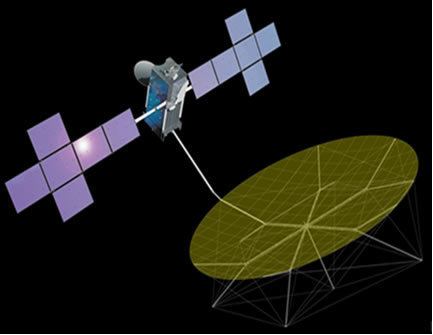COSPAR ID 2009-035A Mission duration 15 years Launch date 1 July 2009 Inclination 4° Rocket Ariane 5 | SATCAT no. 35496 Manufacturer Space Systems Loral Inclination 4° Period 24 hours Bus SSL 1300 | |
 | ||
Similar Optus D3, Nimiq 5, Nanosat‑1B, Progress M‑66, Progress M‑MIM2 | ||
Launch of terrestar 1 via ariane 5 rocket
TerreStar-1 is an American communications satellite which was operated by TerreStar Corporation. It was constructed by Space Systems/Loral, based on the LS-1300S bus, and carries E/F band (IEEE S band) transponders which will be used to provide mobile communications to North America. The signals are transmitted by an 18-metre (59 ft) reflector on the satellite. It had a launch mass of 6,910 kilograms (15,230 lb), making it the most massive single satellite launched into a geosynchronous transfer orbit, and the largest commercial communications satellite ever built at the time of its launch, surpassing the previous two records, both set by ICO G-1 in 2008. Terrestar-1 has since been surpassed in size by the launch of SkyTerra in November 2010, formerly known as Mobile Satellite Ventures.
TerreStar was launched at 17:52 GMT on 2009-07-01, during a two-hour launch window that opened at 16:13. The launch occurred towards the end of the window due to bad weather in the first hour, followed by two aborted countdowns for launch attempts scheduled at 17:12 and 17:34. The launch was conducted by Arianespace, and used an Ariane 5ECA carrier rocket, flying from ELA-3 at the Guiana Space Centre. After launch, the satellite separated from the carrier rocket into a geosynchronous transfer orbit. It will subsequently raise itself into geostationary orbit by means of its onboard propulsion system. It will be positioned at 111° West longitude, and is expected to operate for 15 years. A second satellite, TerreStar-2, is currently under construction and will be used as a ground spare per the Federal Communications Commission guidelines.
Following TerreStar's file for Chapter 11 bankruptcy a movement had been formed by the NGO A Human Right to purchase TerreStar-1 and to use it to provide free basic Internet access to developing countries. The team was looking for $150,000 USD in donations to put the first phase of their plan into action. However, after successfully bidding $1.375 billion for the acquisition of the TerreStar-1 satellite in a bankruptcy-court auction Dish Network on August 22, 2011 asked the Federal Communications Commission to let the company use the wireless spectrum of TerreStar to offer its own wireless broadband service.
